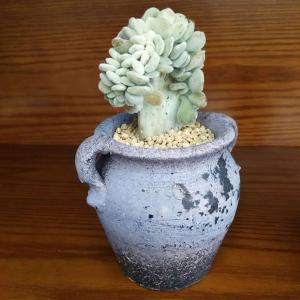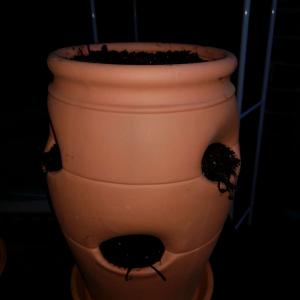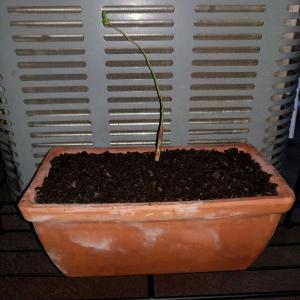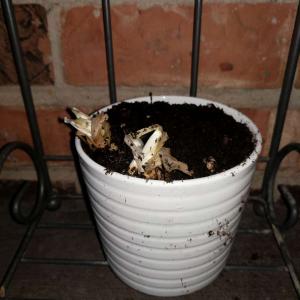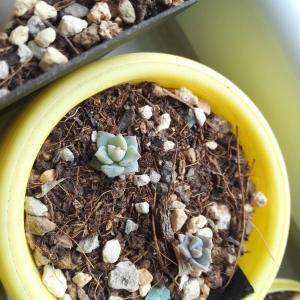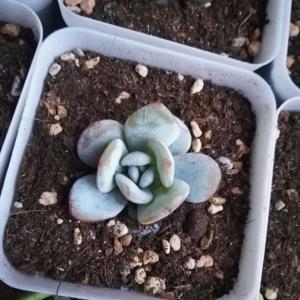心扉的猫咪
2018年03月06日

2018.3.6
1.单瓣长寿继续开开开
2.蟹爪兰开始长新叶
3.小拼盘
4.冻的不行的海棠缓了过来
5.紫色四叶草开始苏醒
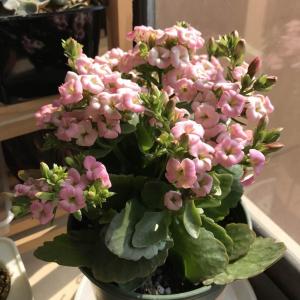
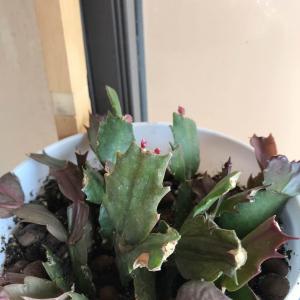
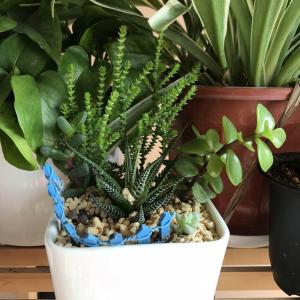
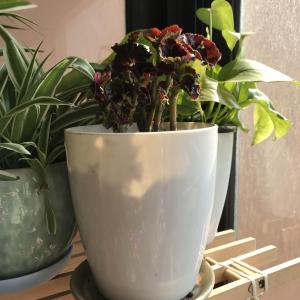
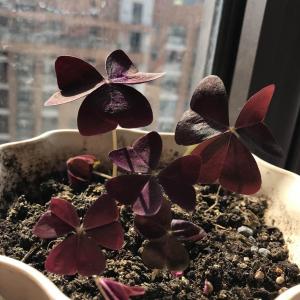
1.单瓣长寿继续开开开
2.蟹爪兰开始长新叶
3.小拼盘
4.冻的不行的海棠缓了过来
5.紫色四叶草开始苏醒





1
0
心扉的猫咪:@lrgarden 春天真美好 万物苏醒
lrgarden:春天来了😄
心扉的猫咪
2018年03月06日

2018.3.6
1.蓝雪苗长势不错,欢了大盆
2.文竹移入了单间,爆出新芽
3.发财树之前都掉光了叶子,今日开始抽新枝
4.三色堇长出新花苞
5.瓜叶菊新买的,看看花而已
6.捡回家的紫罗兰,随便种种
7.不知是小丽花还是大丽花,也是刚捡到的
8.前年的红色重瓣长寿,花苞出了一个多月了,还没开
9.仙客来好像长了虫子,用了药试试看
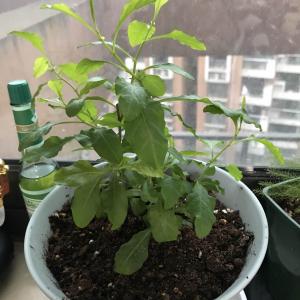
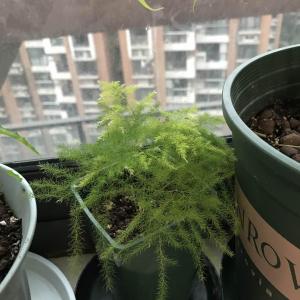
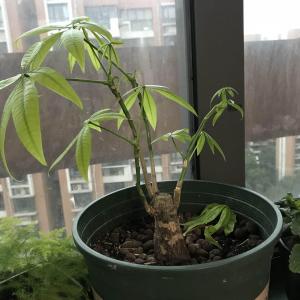
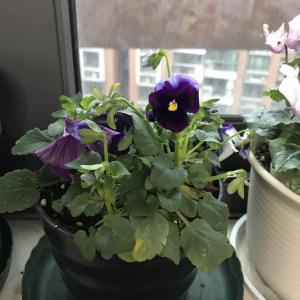
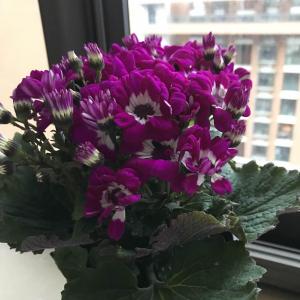
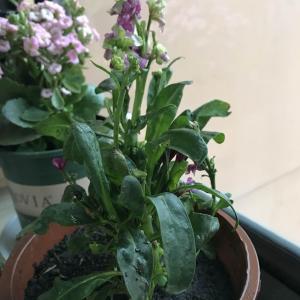
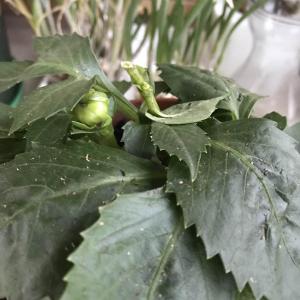
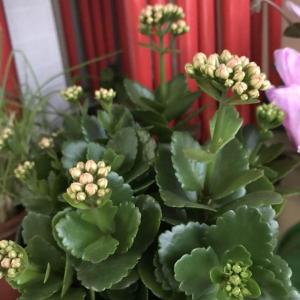

1.蓝雪苗长势不错,欢了大盆
2.文竹移入了单间,爆出新芽
3.发财树之前都掉光了叶子,今日开始抽新枝
4.三色堇长出新花苞
5.瓜叶菊新买的,看看花而已
6.捡回家的紫罗兰,随便种种
7.不知是小丽花还是大丽花,也是刚捡到的
8.前年的红色重瓣长寿,花苞出了一个多月了,还没开
9.仙客来好像长了虫子,用了药试试看









0
0
文章
Miss Chen
2018年03月04日

Description: This perennial herbaceous plant is 2½–4½' tall, sending up one or more leafy stems that are branched above. The central stem is more or less erect, while the lateral stems are ascending. All stems are light green to purple, terete, and moderately to densely pubescent. Pairs of opposite leaves occur along these stems, becoming gradually smaller in size as they ascend. These leaves are 2½–7" long, ¾–2½" across, lanceolate to elliptic in outline, and shallowly to deeply pinnatifid, although the lowest leaves may be bipinnatifid, while the uppermost leaves may be nearly unlobed. The lobes of the leaves are irregular in size and shape; they are often lanceolate, triangular, triangular-curved (shaped like a cresting wave), or rounded. In addition, the leaf margins may be undulate and they may have a few coarse teeth. The leaf surface is yellow green, medium to dark green, or purplish green; the lower leaf surface is slightly more pale than the upper leaf surface. In addition, the leaf surface is sparsely covered with very short hairs.
The leaves are nearly sessile to short-petioled; their petioles are slightly winged and sparsely short-pubescent. The central stem and lateral stems terminate in racemes of flowers with leafy bracts that are about ½–1¼' long. The leafy bracts are ¾–2½" long and ¼–¾" across; these bracts are lanceolate or elliptic in shape and they usually have 2 or more shallow to moderately deep lobes, although some bracts may lack lobes. Except for their smaller size and fewer lobes, the leafy bracts are similar to the leaves below the floral racemes. Individual flowers are about 1½–2¼" long, consisting of a large yellow corolla with 5 spreading lobes, a light green calyx with 5 ascending to spreading lobes, 4 stamens, and an ovary with a single slender style. The corolla is tubular-campanulate (tubular and bell-shaped) in shape, becoming wider towards its mouth; it has a hairless exterior. The lobes of the corolla are oval-orbicular in shape, slightly overlapping, and similar in size. The calyx tube is about ½–¾" long, campanulate in shape, finely ridged, and covered with short fine pubescence.

The lobes of the calyx are elliptic or lanceolate in shape, medium green, and sparsely covered with very short pubescence. The central stalks of the racemes and pedicels of the flowers are light green, terete, and pubescent. In addition, the pedicels are 3-8 mm. long and upturned when the flowers bloom, becoming somewhat longer afterwards when the seed capsules develop. The blooming period occurs from mid-summer to early autumn, lasting about 1–1½ months. There is no noticeable floral scent. Afterwards, the flowers are replaced by ovoid-globoid seed capsules about ½–¾" long that are brown and glabrous. The capsules eventually split open to release theirs seeds. These seeds are about 2 mm. long, ellipsoid-oblong in shape, somewhat flattened, and slightly winged. The root system consists of a caudex with fibrous roots, some of which attach themselves to the roots of trees in the white oak group, from which they withdraw water and nutrients. As a result, this plant is a hemiparasite (partially parasitic).

Cultivation: The preference is partial sun, mesic to dry conditions, sandy loam, clay-loam or rocky soil. The seeds should be planted near a host plant (a tree in the white oak group). This plant will not harm its host plant to any significant degree if the latter is larger in size than a sapling.
Range & Habitat: Large-flowered False Foxglove (Aureolaria grandiflora) is occasional in western and northern Illinois, while in the rest of the state it is uncommon or absent (see Distribution Map). Illinois lies along the eastern range-limit of this plant. Its range occurs primarily in north-central and south-central USA. Habitats include upland oak savannas, edges of limestone glades, thinly wooded bluffs, open woodlands, woodland borders along roadsides, and wooded slopes at the edges of fens. This plant is found in habitats where trees in the white oak group are present in slightly disturbed to high quality natural areas.

Faunal Associations: The nectar and pollen of the flowers attract primarily bumblebees. Other floral visitors include the Ruby-throated Hummingbird, long-horned bees (Melissodes spp.), leaf-cutting bees (Megachile spp.), Halictid bees (Lasioglossum spp.), and Syrphid flies (Robertson, 1929). Syrphid flies, which feed on the pollen, are unlikely to be effective at cross-pollinating the flowers. Other insects feed on either the foliage, sap, or developing seeds of False Foxgloves (Aureolaria spp.). These insects include the larvae of two butterflies, Euphydryas phaeton ozarkae (Baltimore) and Junonia coenia (Buckeye), and the larvae of two moths, Pyrrhia aurantiago (Orange Sallow) and Endothenia hebesana (Verbena Bud Moth). Other insects that have been observed to feed on False Foxgloves include an aphid, Aphis gerardiae, and a skeletonizing leaf beetle, Kuschelina horni.
Photographic Location: Beside an oak tree in a savanna not far from the edge of a fen in Lake County, Illinois.

Comments: Large-flowered False Foxglove (Aureolaria grandiflora) is one of three Aureolaria spp. in Illinois, although there are additional species outside of the state further to the east and south. They are all hemiparasites on the roots of other plants, especially oaks (Quercus spp.). Smooth False Foxglove (Aureolaria flava) has a similar appearance to Large-flowered False Foxglove, except it has hairless stems, hairless pedicels, and hairless calyces on its flowers. In addition, the leafy floral bracts of Smooth False Foxglove are more likely to lack teeth or lobes along their margins. Another species, Fern-leaved False Foxglove (Aureolaria pedicularis), has smaller-sized flowers (1–1½" long) and it is more likely to occur in sandy places where trees in the black oak group occur. The leaves of this latter species are more likely to be bipinnatifid, while the lobes of its calyces are toothed or lobed themselves, instead of smooth along their margins.

Downy False Foxglove (Aureolaria virginica) doesn't occur in Illinois, although it is found in neighboring Indiana. This latter species also has a similar appearance to Large-flowered False Foxglove, except its middle to upper leaves are less lobed or unlobed, and the pedicels of its flowers are shorter (only 1-3 mm. long). The flowers of Downy False Foxglove also tend to be a little shorter in length (1¼–1¾"). Across its range, Large-flowered False Foxglove has been divided into different varieties by some authorities. So far, the only variety that has been reported from Illinois is Aureolaria grandiflora pulchra. At one time, Aureolaria spp. were classified in the Gerardia genus. Thus, a scientific synonym of Large-flowered False Foxglove is Gerardia grandiflora. Another common name for this species is Western False Foxglove, because its range doesn't extend as far to the east as other Aureolaria spp. in eastern North America.
The leaves are nearly sessile to short-petioled; their petioles are slightly winged and sparsely short-pubescent. The central stem and lateral stems terminate in racemes of flowers with leafy bracts that are about ½–1¼' long. The leafy bracts are ¾–2½" long and ¼–¾" across; these bracts are lanceolate or elliptic in shape and they usually have 2 or more shallow to moderately deep lobes, although some bracts may lack lobes. Except for their smaller size and fewer lobes, the leafy bracts are similar to the leaves below the floral racemes. Individual flowers are about 1½–2¼" long, consisting of a large yellow corolla with 5 spreading lobes, a light green calyx with 5 ascending to spreading lobes, 4 stamens, and an ovary with a single slender style. The corolla is tubular-campanulate (tubular and bell-shaped) in shape, becoming wider towards its mouth; it has a hairless exterior. The lobes of the corolla are oval-orbicular in shape, slightly overlapping, and similar in size. The calyx tube is about ½–¾" long, campanulate in shape, finely ridged, and covered with short fine pubescence.

The lobes of the calyx are elliptic or lanceolate in shape, medium green, and sparsely covered with very short pubescence. The central stalks of the racemes and pedicels of the flowers are light green, terete, and pubescent. In addition, the pedicels are 3-8 mm. long and upturned when the flowers bloom, becoming somewhat longer afterwards when the seed capsules develop. The blooming period occurs from mid-summer to early autumn, lasting about 1–1½ months. There is no noticeable floral scent. Afterwards, the flowers are replaced by ovoid-globoid seed capsules about ½–¾" long that are brown and glabrous. The capsules eventually split open to release theirs seeds. These seeds are about 2 mm. long, ellipsoid-oblong in shape, somewhat flattened, and slightly winged. The root system consists of a caudex with fibrous roots, some of which attach themselves to the roots of trees in the white oak group, from which they withdraw water and nutrients. As a result, this plant is a hemiparasite (partially parasitic).

Cultivation: The preference is partial sun, mesic to dry conditions, sandy loam, clay-loam or rocky soil. The seeds should be planted near a host plant (a tree in the white oak group). This plant will not harm its host plant to any significant degree if the latter is larger in size than a sapling.
Range & Habitat: Large-flowered False Foxglove (Aureolaria grandiflora) is occasional in western and northern Illinois, while in the rest of the state it is uncommon or absent (see Distribution Map). Illinois lies along the eastern range-limit of this plant. Its range occurs primarily in north-central and south-central USA. Habitats include upland oak savannas, edges of limestone glades, thinly wooded bluffs, open woodlands, woodland borders along roadsides, and wooded slopes at the edges of fens. This plant is found in habitats where trees in the white oak group are present in slightly disturbed to high quality natural areas.

Faunal Associations: The nectar and pollen of the flowers attract primarily bumblebees. Other floral visitors include the Ruby-throated Hummingbird, long-horned bees (Melissodes spp.), leaf-cutting bees (Megachile spp.), Halictid bees (Lasioglossum spp.), and Syrphid flies (Robertson, 1929). Syrphid flies, which feed on the pollen, are unlikely to be effective at cross-pollinating the flowers. Other insects feed on either the foliage, sap, or developing seeds of False Foxgloves (Aureolaria spp.). These insects include the larvae of two butterflies, Euphydryas phaeton ozarkae (Baltimore) and Junonia coenia (Buckeye), and the larvae of two moths, Pyrrhia aurantiago (Orange Sallow) and Endothenia hebesana (Verbena Bud Moth). Other insects that have been observed to feed on False Foxgloves include an aphid, Aphis gerardiae, and a skeletonizing leaf beetle, Kuschelina horni.
Photographic Location: Beside an oak tree in a savanna not far from the edge of a fen in Lake County, Illinois.

Comments: Large-flowered False Foxglove (Aureolaria grandiflora) is one of three Aureolaria spp. in Illinois, although there are additional species outside of the state further to the east and south. They are all hemiparasites on the roots of other plants, especially oaks (Quercus spp.). Smooth False Foxglove (Aureolaria flava) has a similar appearance to Large-flowered False Foxglove, except it has hairless stems, hairless pedicels, and hairless calyces on its flowers. In addition, the leafy floral bracts of Smooth False Foxglove are more likely to lack teeth or lobes along their margins. Another species, Fern-leaved False Foxglove (Aureolaria pedicularis), has smaller-sized flowers (1–1½" long) and it is more likely to occur in sandy places where trees in the black oak group occur. The leaves of this latter species are more likely to be bipinnatifid, while the lobes of its calyces are toothed or lobed themselves, instead of smooth along their margins.

Downy False Foxglove (Aureolaria virginica) doesn't occur in Illinois, although it is found in neighboring Indiana. This latter species also has a similar appearance to Large-flowered False Foxglove, except its middle to upper leaves are less lobed or unlobed, and the pedicels of its flowers are shorter (only 1-3 mm. long). The flowers of Downy False Foxglove also tend to be a little shorter in length (1¼–1¾"). Across its range, Large-flowered False Foxglove has been divided into different varieties by some authorities. So far, the only variety that has been reported from Illinois is Aureolaria grandiflora pulchra. At one time, Aureolaria spp. were classified in the Gerardia genus. Thus, a scientific synonym of Large-flowered False Foxglove is Gerardia grandiflora. Another common name for this species is Western False Foxglove, because its range doesn't extend as far to the east as other Aureolaria spp. in eastern North America.
0
0
文章
Miss Chen
2018年03月04日

Description: This perennial plant is about 1¾-2¾' tall and unbranched. The central stem is light green, round in cross-section (terete), and glabrous to finely pubescent. The opposite leaves are up to 6" long and 3" across. They are ovate-oblong or broadly lanceolate, with smooth margins that may undulate up and down. The leaves often curl upward from the pinkish central vein. The upper surface of the foliage is mostly glabrous and yellowish green to dark green (depending on light conditions), while the lower surface is light green and softly pubescent (at least along the major veins). Leaf venation is pinnate. The central stem terminates with 1-6 umbels of flowers; there may be a few axillary umbels from some of the upper leaves as well. Each rounded umbel is about 2-3" across. These flowers have the typical structure for milkweeds; they are pale purple to deep purple, sometimes with greenish or rosy tints. However, the central reproductive column and the bases of the deflexed petals are more pale than the rest of the flower.
Flowering Plant
The hoods are much taller than the horns; the latter curve inward toward the reproductive column and appear spike-like (but are slightly thicker toward the base). The blooming period occurs from late spring to mid-summer, and lasts about one month. The flowers have a pleasant fragrance. If cross-pollination occurs, the flowers are replaced by seedpods (follicles) that are held erect. These seedpods are up to 6" long and 1" across; they are narrowly lanceoloid in shape. They have a smooth surface and are finely short-pubescent or canescent. The seeds have large tufts of white hair; they are distributed by the wind. The root system consists of a fleshy taproot and rhizomes; small colonies of plants are sometimes produced from the rhizomes.
Cultivation: The preference is partial sun and mesic conditions; this plant also tolerates light shade and full sun, as well as considerable variations in the moisture regime. Immature plants are inclined to wilt during a drought, and should be watered. The soil can consist of moisture-retaining loam or clay-loam. The plants make rapid growth during the late spring until they flower and form seedpods, then they gradually degenerate. It takes 3 years or more for a small transplant or seedling to reach flowering size. The leaves have tendency to turn yellow and curl in response to dry sunny conditions, or when they become old.
Range & Habitat: The native Purple Milkweed is an occasional plant that is widely distributed in Illinois (see Distribution Map). However, it is uncommon or absent in some areas of NW, central, and east-central Illinois. Habitats include lower slopes of hill prairies, meadows in wooded areas, thickets and woodland borders, bluffs and open woodlands, oak savannas, glades, and roadsides. This plant usually occurs along prairie edges near wooded areas, rather than in open prairie. It is usually found in higher quality habitats.

Faunal Associations: The nectar of the flowers attracts long-tongued bees, butterflies, and skippers. To a lesser extent, green metallic bees and other Halictid bees may visit the flowers, but they are less effective at pollination. Another unusual visitor of the flowers is the Ruby-Throated Hummingbird. Among the butterflies, such visitors as the Pipevine Swallowtail, Giant Swallowtail, American Painted Lady, Red Admiral, Clouded Sulfur, Eastern Tailed-Blue, Regal Fritillary, Great Spangled Fritillary, and many others have been reported. A group of oligophagous insects feed on milkweeds. They include caterpillars of the butterfly Danaus plexippes (Monarch); caterpillars of the moths Cycnia inopinatus (Unexpected Cycnia) and Cycnia tenera (Delicate Cycnia); the aphids Aphis asclepiadis, Aphis nerii, and Myzocallis asclepiadis; Lygaeus kalmii (Small Milkweed Bug) and Oncopeltus fasciatus (Large Milkweed Bug); and Tetraopes tetrophthalmus (Red Milkweed Beetle). Mammalian herbivores rarely consume Purple Milkweed and other milkweeds because of the bitter-tasting, toxic foliage, which contains cardiac glycosides.

Photographic Location: The photographs were taken at the webmaster's wildflower garden in Urbana, Illinois, and at the Coneflower Hill Prairie near Lake Shelbyville in east-central Illinois.
Comments: The flowers of Purple Milkweed are quite attractive. This species is less aggressive than Asclepias syriaca (Common Milkweed), which it resembles somewhat in appearance. However, the flowers of Purple Milkweed are usually a deeper color of purple and more likely to occur in terminal umbels at the apex of the central stem, rather than as axillary umbels between the upper leaves. The seedpods of Purple Milkweed are smooth, while the seedpods of Common Milkweed have soft prickles. Purple Milkweed also resembles Asclepias rubra (Red Milkweed), but the horns on the flowers of the latter species are straight and about as tall as the hoods, while the horns of Purple Milkweed are shorter than the hoods and curve inward toward the reproductive column of the flowers.
Flowering Plant
The hoods are much taller than the horns; the latter curve inward toward the reproductive column and appear spike-like (but are slightly thicker toward the base). The blooming period occurs from late spring to mid-summer, and lasts about one month. The flowers have a pleasant fragrance. If cross-pollination occurs, the flowers are replaced by seedpods (follicles) that are held erect. These seedpods are up to 6" long and 1" across; they are narrowly lanceoloid in shape. They have a smooth surface and are finely short-pubescent or canescent. The seeds have large tufts of white hair; they are distributed by the wind. The root system consists of a fleshy taproot and rhizomes; small colonies of plants are sometimes produced from the rhizomes.
Cultivation: The preference is partial sun and mesic conditions; this plant also tolerates light shade and full sun, as well as considerable variations in the moisture regime. Immature plants are inclined to wilt during a drought, and should be watered. The soil can consist of moisture-retaining loam or clay-loam. The plants make rapid growth during the late spring until they flower and form seedpods, then they gradually degenerate. It takes 3 years or more for a small transplant or seedling to reach flowering size. The leaves have tendency to turn yellow and curl in response to dry sunny conditions, or when they become old.
Range & Habitat: The native Purple Milkweed is an occasional plant that is widely distributed in Illinois (see Distribution Map). However, it is uncommon or absent in some areas of NW, central, and east-central Illinois. Habitats include lower slopes of hill prairies, meadows in wooded areas, thickets and woodland borders, bluffs and open woodlands, oak savannas, glades, and roadsides. This plant usually occurs along prairie edges near wooded areas, rather than in open prairie. It is usually found in higher quality habitats.

Faunal Associations: The nectar of the flowers attracts long-tongued bees, butterflies, and skippers. To a lesser extent, green metallic bees and other Halictid bees may visit the flowers, but they are less effective at pollination. Another unusual visitor of the flowers is the Ruby-Throated Hummingbird. Among the butterflies, such visitors as the Pipevine Swallowtail, Giant Swallowtail, American Painted Lady, Red Admiral, Clouded Sulfur, Eastern Tailed-Blue, Regal Fritillary, Great Spangled Fritillary, and many others have been reported. A group of oligophagous insects feed on milkweeds. They include caterpillars of the butterfly Danaus plexippes (Monarch); caterpillars of the moths Cycnia inopinatus (Unexpected Cycnia) and Cycnia tenera (Delicate Cycnia); the aphids Aphis asclepiadis, Aphis nerii, and Myzocallis asclepiadis; Lygaeus kalmii (Small Milkweed Bug) and Oncopeltus fasciatus (Large Milkweed Bug); and Tetraopes tetrophthalmus (Red Milkweed Beetle). Mammalian herbivores rarely consume Purple Milkweed and other milkweeds because of the bitter-tasting, toxic foliage, which contains cardiac glycosides.

Photographic Location: The photographs were taken at the webmaster's wildflower garden in Urbana, Illinois, and at the Coneflower Hill Prairie near Lake Shelbyville in east-central Illinois.
Comments: The flowers of Purple Milkweed are quite attractive. This species is less aggressive than Asclepias syriaca (Common Milkweed), which it resembles somewhat in appearance. However, the flowers of Purple Milkweed are usually a deeper color of purple and more likely to occur in terminal umbels at the apex of the central stem, rather than as axillary umbels between the upper leaves. The seedpods of Purple Milkweed are smooth, while the seedpods of Common Milkweed have soft prickles. Purple Milkweed also resembles Asclepias rubra (Red Milkweed), but the horns on the flowers of the latter species are straight and about as tall as the hoods, while the horns of Purple Milkweed are shorter than the hoods and curve inward toward the reproductive column of the flowers.
0
0




